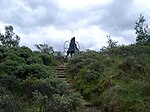Louwman Museum
Automobile museums in the NetherlandsMichael Graves buildingsMuseums in The HagueNew Classical architecture

The Louwman Museum is a museum for historic cars, coaches, and motorcycles in The Hague, Netherlands. It is situated on the Leidsestraatweg near the A44 highway. The museum's former names are "Nationaal Automobiel Museum" and "Louwman Collection".
Excerpt from the Wikipedia article Louwman Museum (License: CC BY-SA 3.0, Authors, Images).Louwman Museum
Leidsestraatweg, The Hague Haagse Hout
Geographical coordinates (GPS) Address Phone number Website External links Nearby Places Show on map
Geographical coordinates (GPS)
| Latitude | Longitude |
|---|---|
| N 52.099780555556 ° | E 4.3505027777778 ° |
Address
Louwman Museum
Leidsestraatweg 65
2594 BB The Hague, Haagse Hout
South Holland, Netherlands
Open on Google Maps










